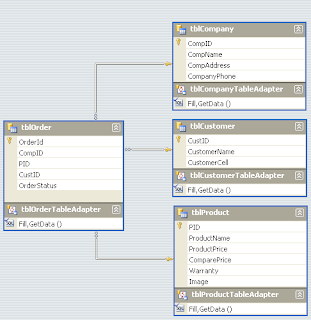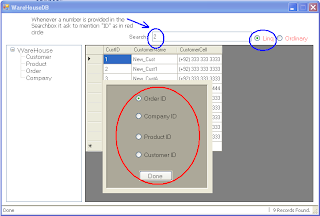This article completely demonstrates the procedure for displaying the selected row of datagridview in a new form and allows edit and update. This will be done by generating textboxes and labels dynamically. Vb.Net versions for the sample code is shown.The DB is designed in SSMSE2005.
Database's attributes and relationship:
When row selected:
After edit Done button is pressed as a result a confirmation is appeared.
Description:
To get the selected row from datagridview we have several events to make use of but I selected two of them and by comparing the behavior (sequence of firing) of these events, one event was rejected. The events are:
- datagridview_Selectionchanged
- datagridview_CellClick
If datagridview_Selectionchanged event will be used to bind the source of datagridview and a piece of code to generate new form will be added, at a time of loading of form this event will fire ‘n’ times where n is the number of rows the datagridview source will contain. IT would be pathetic to a user to close the form ‘n’ times when not needed. So, this event will be rejected.
On the other hand, the datagridview_CellClick event will only fire when user will select a cell, at that time we will use datagridview.currentrow property.
Namespaces used:
VB.Net
Imports System
Imports System.Data
Imports System.Data.Sql
Imports System.Data.SqlClient
Imports System.Linq
Declarations:
FrmMain:
VB.Net
Dim constr As String = "Data Source=.\SQLEXPRESS;AttachDbFilename=C:\Program Files\Microsoft SQL Server\MSSQL.1\MSSQL\Data\WareHouse.mdf;Integrated Security=True;Connect Timeout=30;User Instance=True"
Dim da As SqlDataAdapter
Dim ds As DataSet
Dim cmd As SqlCommand
Dim con As SqlConnection
FrmDetails:
VB.Net
Dim Items As ArrayList
Dim StartingPoint As Point = New Point(20, 40)
Dim txtboxes As New List(Of CustomTextbox)
Dim labels As New List(Of CustomLabel)
Here you will see two new custom datatypes CustomTextbox and CustomLabel, this is designed to create such a textbox and Label which best fits to our requirement. Here are the classes:
VB.Net:
Public Class CustomTextbox
Inherits TextBox
Dim txtboxWidth As Integer = 140
Dim Newfont As New Font("Moire", 12, FontStyle.Regular, GraphicsUnit.Pixel, 1)
Public Sub New()
MyBase.Font = Newfont
MyBase.Width = txtboxWidth
MyBase.ForeColor = Color.Blue
MyBase.Text = "Not Assigned Yet" //bydefault a value set
End Sub
End Class
Public Class CustomLabel
Inherits Label
Dim Newfont As New Font("Moire", 12, FontStyle.Regular, GraphicsUnit.Pixel, 1)
Public Sub New()
MyBase.Font = Newfont
MyBase.ForeColor = Color.Red
End Sub
End Class
The most important part is this part, where in FrmMain, on DatagridView_CellClick the information is gathered and passed to FrmDetails, the code is as below:
VB.Net
con = New SqlConnection(constr)
con.Open()
cmd = New SqlCommand("Select * from " & treeDataBase.SelectedNode.Tag, con)
Dim size As Integer = cmd.ExecuteReader().FieldCount
If Not IsDBNull(dgrid.CurrentRow.Cells(0).Value) Then ' cells(0) is primary key
Dim contents As ArrayList = New ArrayList(dgrid.CurrentRow.Cells)
Dim f As New FrmDetails
f.DetectControlSetting(contents)
f.ShowDialog()
con.Close()
ReleaseResources()
End If
con.Close()
Here DetectControlSetting is a static method on FrmDetail,
Public Sub DetectControlSetting(ByVal contents As ArrayList)
Items = New ArrayList
Items.AddRange(contents.ToArray)
End Sub
to provide data to this form. At this step the grid data saves into an ArrayList object in FrmDetail. Here is the code:
VB.Net
Items = New ArrayList
Items.AddRange(contents.ToArray)
On Form_Load event of FrmDetail we need to generate the CustomTextbox and CustomLabel for Display as mentioned above.
The code used is:
VB.Net
Private Sub FrmDetails_Load(ByVal sender As System.Object, ByVal e As System.EventArgs) Handles MyBase.Load
For i As Integer = 0 To Items.Count - 1
txtboxes.Add(New CustomTextbox)
labels.Add(New CustomLabel())
If Not IsDBNull(CType(Items(i), DataGridViewTextBoxCell).Value) Then
labels.Item(i).Text = CType(Items(i), DataGridViewTextBoxCell).OwningColumn.HeaderText
labels.Item(i).Left = StartingPoint.X : labels.Item(i).Top = StartingPoint.Y
txtboxes.Item(i).Text = CType(Items(i), DataGridViewTextBoxCell).Value
txtboxes.Item(i).Left = StartingPoint.X + 130 : txtboxes.Item(i).Top = StartingPoint.Y ' X + 130 is controls Gap
StartingPoint = New Point(StartingPoint.X, StartingPoint.Y + 50)
Else
labels.Item(i).Text = CType(Items(i), DataGridViewTextBoxCell).OwningColumn.HeaderText
txtboxes.Item(i).Left = StartingPoint.X + 130 : txtboxes.Item(i).Top = StartingPoint.Y ' X + 130 is distance between controls
labels.Item(i).Left = StartingPoint.X : labels.Item(i).Top = StartingPoint.Y
End If
Next
Me.Controls.AddRange(txtboxes.ToArray)
Me.Controls.AddRange(labels.ToArray)
Me.Height = txtboxes.Item(Items.Count - 1).Bottom + 100
btnDone.Top = txtboxes.Item(Items.Count - 1).Bottom + 30
btnDone.Left = (Me.Width / 2) - (btnDone.Width / 2)
'IDs should be protected from editing
For Each tb As CustomTextbox In txtboxes
If IsNumeric(tb.Text) And Not tb.Text.Contains(".") Then
tb.ReadOnly = True
End If
Next
End Sub
At FrmDetail, we have a button to update the data and close the form, let’s see how it is possible:(Select and switch is preferred instead of IF...Then...Else)
To update the data:
VB.Net
Dim con As New SqlConnection("Data Source=.\SQLEXPRESS;AttachDbFilename=C:\Program Files\Microsoft SQL Server\MSSQL.1\MSSQL\Data\WareHouse.mdf;Integrated Security=True;Connect Timeout=30;User Instance=True")
Dim cmd As New SqlCommand()
con.Open()
Select Case tablename
Case "tblProduct"
cmd.CommandText = "Update " & tablename & " SET ProductName ='" & txtboxes.Item(1).Text & "',ProductPrice=" & txtboxes.Item(2).Text & " where PID=" & txtboxes.Item(0).Text & ";"
Case "tblCustomer"
cmd.CommandText = "Update " & tablename & " SET CustomerName ='" & txtboxes.Item(1).Text & "',CustomerCell='" & txtboxes.Item(2).Text & "' where CustID=" & txtboxes.Item(0).Text & ";"
Case "tblOrder"
cmd.CommandText = "Update " & tablename & " SET OrderStatus ='" & txtboxes.Item(4).Text & "' where OrderID= " & txtboxes.Item(0).Text & " and CompID= " & txtboxes.Item(1).Text & " and PID= " & txtboxes.Item(2).Text & " and CustID= " & txtboxes.Item(3).Text & ";"
Case "tblCompany"
cmd.CommandText = "Update " & tablename & " SET CompName ='" & txtboxes.Item(1).Text & "',CompAddress='" & txtboxes.Item(2).Text & "',CompanyPhone='" & txtboxes.Item(3).Text & "' where CompID=" & txtboxes.Item(0).Text & ";"
End Select
FrmMain.treeDataBase.SelectedNode = FrmMain.treeDataBase.Nodes(tablename)
cmd.Connection = con
cmd.ExecuteNonQuery()
con.Close()
FrmMain.dgrid.Refresh()
MessageBox.Show("Result Updated.", "Editing result", MessageBoxButtons.OK, MessageBoxIcon.Information)
Me.Close()
At this point the Datagrid will be populated with the updated result.
Cheers!!!!!
Regards,
Engr. Shahan Ayyub






